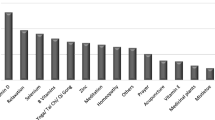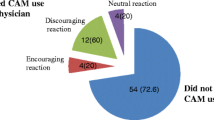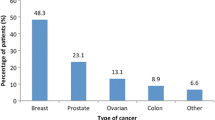Abstract
Purpose
Scant literature exists on the use of complementary and alternative medicine (CAM) among patients with lung cancer. Preliminary data indicates that perceived control is an important factor leading patients to CAM. This study aimed to evaluate the relationship between perceived control and CAM use in patients with lung cancer.
Methods
We performed a cross-sectional survey in patients with lung cancer under active treatment and follow-up at the oncology clinic of an academic medical center. Self-reported CAM use was the primary outcome. Multivariate logistic regression was performed to determine the relationship between perceived control and CAM use, controlling for other factors.
Results
Among 296 participants, 54.4 % were female, 83.5 % were Caucasian, 57.6 % were ≤65 years old, 52.4 % were in stage IV, and 86.4 % had non-small cell lung cancer; 50.9 % of patients had used CAM, most commonly vitamins (31.5 %), herbs (19.3 %), relaxation techniques (16 %), and special diets (15.7 %). In multivariate analysis, CAM use was associated with having greater perceived control over the cause of cancer (adjusted odds ratio (AOR) 2.27, 95 % confidence interval (CI) 1.35–3.80), age ≤ 65 (AOR 1.64, 95 % CI 1.01–2.67), higher education (AOR 2.17, 95 % CI 1.29–3.64), and never having smoked tobacco (AOR 2.39, 95 % CI 1.25–4.54). Nearly 60 % of patients who used CAM were receiving active treatment.
Conclusion
Over half of lung cancer patients have used CAM since diagnosis. Greater perceived control over the cause of cancer was associated with CAM use. Given the high prevalence of CAM, it is essential that oncologists caring for patients with lung cancer discuss its use.


Similar content being viewed by others
References
Amichai T, Grossman M, Richard M (2012) Lung cancer patients’ beliefs about complementary and alternative medicine in the promotion of their wellness. Eur J Oncol Nurs Off J Eur Oncol Nurs Soc 16:520–527
Balneaves LG, Kristjanson LJ, Tataryn D (1999) Beyond convention: describing complementary therapy use by women living with breast cancer. Patient Educ Couns 38:143–153
Barez M, Blasco T, Fernandez-Castro J, Viladrich C (2007) A structural model of the relationships between perceived control and adaptation to illness in women with breast cancer. J Psychosoc Oncol 25:21–43
Boon H, Stewart M, Kennard MA, Gray R, Sawka C, Brown JB, McWilliam C, Gavin A, Baron RA, Aaron D, Haines-Kamka T (2000) Use of complementary/alternative medicine by breast cancer survivors in Ontario: prevalence and perceptions. J Clin Oncol 18:2515–2521
Chapple A, Ziebland S, McPherson A (2004) Stigma, shame, and blame experienced by patients with lung cancer: qualitative study. BMJ 328:1470
Costanzo ES, Lutgendorf SK, Roeder SL (2011) Common-sense beliefs about cancer and health practices among women completing treatment for breast cancer. Psychooncology 20:53–61
D'Andrea GM (2005) Use of antioxidants during chemotherapy and radiotherapy should be avoided CA. Cancer J Clin 55:319–321
Degner LF, Sloan JA (1995) Symptom distress in newly diagnosed ambulatory cancer patients and as a predictor of survival in lung cancer. J Pain Symptom Manag 10:423–431
DeSalvo KB, Bloser N, Reynolds K, He J, Muntner P (2006) Mortality prediction with a single general self-rated health question. A meta-analysis. J Gen Intern Med 21:267–275
Eisenberg DM, Kessler RC, Van Rompay MI, Kaptchuk TJ, Wilkey SA, Appel S, Davis RB (2001) Perceptions about complementary therapies relative to conventional therapies among adults who use both: results from a national survey. Ann Intern Med 135:344–351
Faller H, Schilling S, Lang H (1995) Causal attribution and adaptation among lung cancer patients. J Psychosom Res 39:619–627
Frenkel M, Abrams DI, Ladas EJ, Deng G, Hardy M, Capodice JL, Winegardner MF, Gubili JK, Yeung KS, Kussmann H, Block KI (2013) Integrating dietary supplements into cancer care. Integr Cancer Ther 2(5):369–384
Gansler T, Kaw C, Crammer C, Smith T (2008) A population-based study of prevalence of complementary methods use by cancer survivors: a report from the American Cancer Society’s studies of cancer survivors. Cancer 113:1048–1057
Ge J, Fishman J, Vapiwala N, Li SQ, Desai K, Xie SX, Mao JJ (2013) Patient-physician communication about complementary and alternative medicine in a radiation oncology setting. Int J Radiat Oncol Biol Phys 85:e1–e6
Gerrig RJ, Zimbardo PG (2002) Psychology and life. Allyn and Bacon, Boston
Henderson JW, Donatelle RJ (2003) The relationship between cancer locus of control and complementary and alternative medicine use by women diagnosed with breast cancer. Psychooncology 12:59–67
Irwin KE, Greer JA, Khatib J, Temel JS, Pirl WF (2013) Early palliative care and metastatic non-small cell lung cancer: potential mechanisms of prolonged survival. Chron Respir Dis 10:35–47
Kidd L, Hubbard G, O'Carroll R, Kearney N (2009) Perceived control and involvement in self care in patients with colorectal cancer. J Clin Nurs 18:2292–2300
Lee RT, Hlubocky FJ, Hu JJ, Stafford RS, Daugherty CK (2008) An international pilot study of oncology physicians’ opinions and practices on Complementary and Alternative Medicine (CAM). Integr Cancer Ther 7:70–75
Lövgren M, Wilde-Larsson B, Hök J (2011) Push or pull? Relationships between lung cancer patients’ perceptions of quality of care and use of complementary and alternative medicine. Eur J Oncol Nurs 15(4):311–7. doi:10.1016/j.ejon.2010.10.004
Maggiore RJ, Gross CP, Togawa K, Tew WP, Mohile SG, Owusu C, Klepin HD, Lichtman SM, Gajra A, Ramani R, Katheria V, Klapper SM, Hansen K, Hurria A, on behalf of the C, Aging Research G (2012) Use of complementary medications among older adults with cancer. Cancer 118:4815–4823
Mao JJ, Cronholm PF, Stein E, Straton JB, Palmer SC, Barg FK (2010) Positive changes, increased spiritual importance, and complementary and alternative medicine (CAM) use among cancer survivors. Integr Cancer Ther 9:339–347
Mao JJ, Farrar JT, Xie SX, Bowman MA, Armstrong K (2007) Use of complementary and alternative medicine and prayer among a national sample of cancer survivors compared to other populations without cancer. Complement Ther Med 15:21–29
Mao JJ, Palmer CS, Healy KE, Desai K, Amsterdam J (2011) Complementary and alternative medicine use among cancer survivors: a population-based study. J Cancer Surviv Res Pract 5:8–17
Molassiotis A, Panteli V, Patiraki E, Ozden G, Platin N, Madsen E, Browall M, Fernandez-Ortega P, Pud D, Margulies A (2006) Complementary and alternative medicine use in lung cancer patients in eight European countries. Complement Ther Clin Pract 12:34–39
Montazeri A, Milroy R, Hole D, McEwen J, Gillis CR (2001) Quality of life in lung cancer patients: as an important prognostic factor. Lung Cancer 31:233–240
O'Connell JP, Kris MG, Gralla RJ, Groshen S, Trust A, Fiore JJ, Kelsen DP, Heelan RT, Golbey RB (1986) Frequency and prognostic importance of pretreatment clinical characteristics in patients with advanced non-small-cell lung cancer treated with combination chemotherapy. J Clin Oncol 4:1604–1614
Omenn GS, Goodman GE, Thornquist MD, Balmes J, Cullen MR, Glass A, Keogh JP, Meyskens FL, Valanis B, Williams JH, Barnhart S, Hammar S (1996) Effects of a combination of beta carotene and vitamin A on lung cancer and cardiovascular disease. N Engl J Med 334:1150–1155
Paltiel O, Avitzour M, Peretz T, Cherny N, Kaduri L, Pfeffer RM, Wagner N, Soskolne V (2001) Determinants of the use of complementary therapies by patients with cancer. J Clin Oncol 19:2439–2448
Paull DE, Thomas ML, Meade GE, Updyke GM, Arocho MA, Chin HW, Adebonojo SA, Little AG (2006) Determinants of quality of life in patients following pulmonary resection for lung cancer. Am J Surg 192:565–571
Polley MJ, Seers HE, Cooke HJ, Hoffman C, Paterson C (2007) How to summarise and report written qualitative data from patients: a method for use in cancer support care. Support Care Cancer 15:963–971
Richardson MA, Sanders T, Palmer JL, Greisinger A, Singletary SE (2000) Complementary/alternative medicine use in a comprehensive cancer center and the implications for oncology. J Clin Oncol 18:2505–2514
Schag CA, Ganz PA, Wing DS, Sim MS, Lee JJ (1994) Quality of life in adult survivors of lung, colon and prostate cancer. Qual Life Res Int J Qual Life Asp Treat Care Rehab 3:127–141
Seers HE, Gale N, Paterson C, Cooke HJ, Tuffrey V, Polley MJ (2009) Individualised and complex experiences of integrative cancer support care: combining qualitative and quantitative data. Support Care Cancer 17:1159–1167
Shumay DM, Maskarinec G, Gotay CC, Heiby EM, Kakai H (2002) Determinants of the degree of complementary and alternative medicine use among patients with cancer. J Altern Complement Med 8:661–671
Siegel R, Naishadham D, Jemal A (2013) Cancer statistics, 2013. CA Cancer J Clin 63:11–30
Sparreboom A, Cox MC, Acharya MR, Figg WD (2004) Herbal remedies in the United States: potential adverse interactions with anticancer agents. J Clin Oncol 22:2489–2503
Tanaka K, Akechi T, Okuyama T, Nishiwaki Y, Uchitomi Y (2002) Impact of dyspnea, pain, and fatigue on daily life activities in ambulatory patients with advanced lung cancer. J Pain Symptom Manag 23:417–423
Temel JS, Greer JA, Muzikansky A, Gallagher ER, Admane S, Jackson VA, Dahlin CM, Blinderman CD, Jacobsen J, Pirl WF, Billings JA, Lynch TJ (2010) Early palliative care for patients with metastatic non-small-cell lung cancer. N Engl J Med 363:733–742
Watson M, Pruyn J, Greer S, van den Borne B (1990) Locus of control and adjustment to cancer. Psychol Rep 66:39–48
Wells M, Sarna L, Cooley ME, Brown JK, Chernecky C, Williams RD, Padilla G, Danao LL (2007) Use of complementary and alternative medicine therapies to control symptoms in women living with lung cancer. Cancer Nurs 30:45–55, quiz 56–47
Yates JS, Mustian KM, Morrow GR, Gillies LJ, Padmanaban D, Atkins JN, Issell B, Kirshner JJ, Colman LK (2005) Prevalence of complementary and alternative medicine use in cancer patients during treatment. Support Care Cancer 13:806–811
Acknowledgments
We would like to thank all of the patients who participated in this study. We thank the physicians, nurse practitioners, and staff for their support. We would like to thank our hardworking students, Eitan Frankel, Jonathan Burgess, Blake Freidman, Manuel Bramble, Neha Agarwal, and Tiffany Tan for their dedication to the data collection and management process. We thank Mr. Duncan Hennes for his support of the Penn Integrative Oncology Program.
Conflict of interest
This study is partially funded by the Penn Institute of Aging Pilot Fund. Dr. Mao is supported by the National Institutes of Health [1K23 AT004112-05]. The content is solely the responsibility of the authors and does not necessarily represent the official views of the National Institutes of Health. The authors have full control of the primary data, which is available to the journal at their request for review.
Author information
Authors and Affiliations
Corresponding author
Rights and permissions
About this article
Cite this article
Bauml, J., Langer, C.J., Evans, T. et al. Does perceived control predict Complementary and Alternative Medicine (CAM) use among patients with lung cancer? A cross-sectional survey. Support Care Cancer 22, 2465–2472 (2014). https://doi.org/10.1007/s00520-014-2220-5
Received:
Accepted:
Published:
Issue Date:
DOI: https://doi.org/10.1007/s00520-014-2220-5




